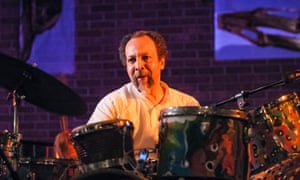The pioneering free jazz drummer Milford Graves, who was credited with transforming the role from metronome to musician, has died aged 79, NPR has confirmed. The cause of death was congestive heart failure.
Musicians including Vijay Iyer, Superchunk, Oren Ambarchi, Moor Mother, Clipping and Ryley Walker paid tribute to Graves. Jazz critic Nate Chinen said he was “a creative galaxy in human form. Unfolding possibility in every molecule.”
In 2018 Graves was diagnosed with amyloid cardiomyopathy, also known as stiff heart syndrome, and given six months to live. The Queens-born musician had studied the heartbeat as a source of rhythm since the 1970s, encouraging other players to incorporate the tempo of their pulse into their performance.
“It’s like some higher power saying: ‘OK, buddy, you wanted to study this, here you go,” he told the New York Times soon after his diagnosis. “Now the challenge is inside of me.”
Graves performing at the Hopscotch festival in Raleigh, North Carolina, in 2018.He made his illness part of his music and his work as a visual artist, believing that heart conditions might be helped by making recordings of an unhealthy heartbeat and then musically performing a healthier rhythm to encourage biofeedback. A recent exhibition at the Philadelphia Institute of Contemporary Art surveyed his career up to his most recent works.
Born on 20 August 1941, Graves started playing the drums aged three and soon expanded his studies. In his early 20s he performed in dance and Latin groups in New York; hearing the John Coltrane Quartet with Elvin Jones inspired him to push his own musical explorations, transposing the dance moves from his Latin band days into a new technique: “So I said: ‘That’s all I’ll do. I’m going to start dancing down below,’” he told the New York Times. “I started dancing on the high-hat.”
He developed a unique style and setup, as described by critic Val Wilmer in her book As Serious As Your Life:
Graves moved around his drumset with astonishing speed, beating rapid two-handed tattoos on every surface. Each stroke was clearly defined so that there were no rolls in the conventional sense; the emphasis was on clarity. He used his cymbals in the way another drummer might use a gong or another drum. With the NYAQ [New York Art Quartet], Graves’s snare drum was tuned high as was the norm, but already his tom-toms were producing a deeper sound than usual. By the end of the 60s, though, he had dispensed with the snare and his three tom-toms were tuned as loosely as is common in rock today ... Graves was probably the first American drummer to remove all of his bottom heads because of their tendency to absorb sound.
By 1964 he had joined Roswell Rudd, Giuseppi Logan and John Tchicai in the New York Art Quartet. That decade, he would play with Albert Ayler’s trio, Miriam Makeba and Sonny Sharrock, and released the album Percussion Ensemble alongside drummer Sonny Morgan, which has been hailed as one of the greatest percussion albums of all time.
Graves would later collaborate with Sun Ra, John Zorn, Anthony Braxton, Bill Laswell, Lou Reed and Sam Amidon.
He also pursued a vast array of nonmusical endeavours – natural healing, herbology and frontline science – believing them to be complementary practices to encourage healing and consciousness. In the 1970, he invented Yara, a form of martial arts based on the physicality of the praying mantis. He taught at Bennington College in Vermont on a variety of subjects from 1973 to 2012.
Milford Graves Full Mantis review – cutting-edge drums and terrific...
4 out of 5 stars.In 2000, Graves was named a Guggenheim Fellow, and used some of the prize funds to further his studies into the relationship between music and the heart. In 2017, he and a group of Italian biologists patented stem cell regeneration technology that uses frequency response.
Jazz critic John Corbett wrote: “Graves’s heart studies … confirm the falsity of one of the easiest potshots taken at nonmetrical or polymetrical drumming in free jazz, namely, that it’s unnatural and doesn’t mimic the heart, which is assumed to have a steady beat.”
Also in 2018, Graves was the subject of a documentary, Milford Graves Full Mantis. Director Jake Meginsky, who studied with Graves for 15 years, told the Quietus of his subject’s “almost scientist’s drive to explain his creative process, [which] is clearly extremely complex and dynamic. He’s not cagey or protective. He’s filled with energy to share. That’s a rare thing for a musician.”
• This article was amended on 13 February 2021. In an earlier version the musician Roswell Rudd was incorrectly named as Roswell Judd.
